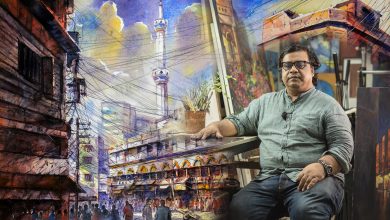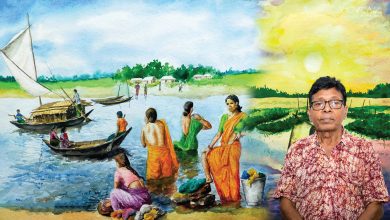In the story of Bangladesh’s art, some names shimmer quietly — not loud, not showy, but steady and enduring. Sculptor Alak Roy is one such name. His art does not shout for attention; it draws you in slowly, like the way sunlight reveals the texture of old terracotta after rain. To encounter his work is to feel time itself — layered, weathered, and beautifully human.

Born in 1950 in Mymensingh, Alak Roy grew up surrounded by the rhythms of rural Bengal — the earth, the rivers, the crafts, and the hands that shaped them. Those early impressions never left him. They reappear decades later in his sculptures — in the curve of a clay torso, the fissure of a fired surface, or the stillness of a stone figure that feels as old as the land itself.

Roy studied at the College of Arts and Crafts in Dhaka (now the Faculty of Fine Arts, University of Dhaka), graduating in 1973 — a time when the country, newly independent, was discovering its voice. He later went to Baroda for his Master’s degree, joining one of South Asia’s most progressive art schools. That journey — from the rural heart of Bangladesh to the intellectual hub of Baroda — shaped his worldview. He returned home with a deeper appreciation for local craft traditions, but also with the tools to think of sculpture in global, conceptual terms.



To describe Alak Roy’s sculptures is to describe conversations between materials and memories. He works with clay, stone, steel, and bronze, yet what emerges is not just form — it is feeling. His surfaces are never smooth or polished; they retain the artist’s fingerprints, the marks of making, the record of touch.
“Each scar, each crack is a memory,” Roy once said in an interview. “You don’t erase history from the skin of your work.”

This philosophy breathes through his art. His sculptures hold the essence of Bangladesh’s soil, as if the land itself speaks through his hands. Sometimes his figures seem to grow out of the ground, their limbs merging with the earth. Sometimes, they appear eroded — almost fossil-like — as if they’ve endured centuries of wind, heat, and human silence.

Critics often describe Roy’s works as “portraits of time.” There’s a meditative slowness in them, a sense that everything — human or natural — eventually returns to the same source. His forms are not heroic or idealized; they are ordinary, almost humble, yet filled with quiet dignity. They remind us that art doesn’t need to impress — it can simply be.
Roy’s deep relationship with material defines his artistic language. He often begins with clay — the most ancient of sculptural mediums, the one closest to human life. Clay, for him, is alive. It breathes, it cracks, it resists, it transforms in the kiln. He allows these imperfections to remain visible. “Clay teaches you patience,” he says. “You cannot rush fire or earth.”

His ceramic works often carry the warmth of terracotta traditions — echoing the Bengal temple panels of Bishnupur and Kantanagar — yet they are unmistakably modern in spirit. Some pieces resemble fragmented human figures, others abstract, organic shapes. The glazes shimmer like dried riverbeds, sometimes burnt, sometimes cool. You can sense both fragility and resilience within them — the same duality that defines life in this delta land.

When he works in steel or stone, his approach shifts, but the philosophy remains. The work titled The Old Man in the Mountain’s New Home, made during the Andres Institute Sculpture Symposium in New Hampshire, is a striking example. In it, a weathered boulder is held by a delicate steel frame — a poetic gesture that merges the permanence of rock with the transience of human intervention. The piece reads like a metaphor for belonging, for finding one’s place in the world.
If there is a thread that connects Roy’s decades of work, it is his fascination with ecology — both environmental and psychological. His exhibitions often bear titles like Steps to Ecology of Mind, suggesting that nature, thought, and art are intertwined. His sculptures are less about depicting the natural world and more about understanding our emotional connection to it.

He sees nature not as a distant landscape but as an extension of the self. In one of his series, clay forms twist into root-like structures, as if bodies and trees share the same pulse. In another, figures seem to emerge from geological layers, reminding us of our shared origin in dust and stone.
This approach places Roy in dialogue with contemporary ecological art, yet his sensibility remains rooted in Bangladeshi soil — literally and culturally. He doesn’t romanticize nature; he reveals its endurance, its scars, its unspoken intelligence.
Beyond his personal practice, Alak Roy has been a guiding presence for many young artists. As a professor of sculpture at the Institute of Fine Arts, Chattogram University, he spent decades mentoring students — teaching them not only how to sculpt, but how to see.
Students recall his studio as a space of quiet focus. There was no strict formula, no rigid hierarchy. Roy encouraged exploration. “Listen to your material,” he would say. “It will tell you what it wants to become.”
In a country where art education often struggles for resources, Roy’s insistence on craftsmanship — on understanding weight, form, and balance through one’s hands — became a form of resistance. His students still speak of his generosity, his calm, and his deep respect for process.
Roy’s work has appeared in numerous national exhibitions at Bangladesh Shilpakala Academy and in international symposiums that connected him with sculptors from around the world. Each event added a layer to his evolution — from the 3rd International Competition and Exhibition of Painting and Sculpture in Kolkata to collaborative sculpture festivals and group shows across South Asia.
While his name may not dominate global headlines, within Bangladesh’s art community he is seen as a quiet cornerstone — someone who kept sculpture alive through changing times, who proved that patience and integrity can outlast trends.
His recognition includes awards from Bengal Foundation and appreciation from cultural institutions for his contribution to both artistic practice and education. Yet, Roy remains characteristically humble. “Art,” he once said, “is not about being seen. It’s about learning to see.”
Encountering an Alak Roy sculpture is a deeply sensory experience. You might find yourself tracing the grooves of a clay face, feeling the pulse of a welded joint, or sensing the weight of silence in his stone forms. There’s an honesty to his textures — a refusal to hide the labor behind beauty.
His works often evoke dualities: strength and fragility, permanence and decay, body and landscape. In doing so, they become mirrors of life in Bangladesh — a place of constant transformation, where floods and growth, creation and erosion, coexist.

For Roy, sculpture is more than form-making. It is a way of recording time — the slow sediment of living, the layers of touch and memory that make us human. “When you hold clay,” he once said, “you hold the past. When you shape it, you touch the future.”
Today, Alak Roy stands as one of the quiet masters of Bangladeshi sculpture — a figure whose legacy is written not in grand monuments, but in the integrity of his craft. His art bridges the tactile and the spiritual, the intimate and the monumental.

In a world increasingly obsessed with spectacle, Roy reminds us that beauty can also live in silence — in the fingerprint left on clay, in the patient burn of a kiln, in the steady gaze of a sculptor who listens more than he speaks.

His work invites us to slow down, to look closely, to feel deeply. Because sometimes, the earth itself is telling a story — and in the hands of Alak Roy, we finally learn to hear it.




